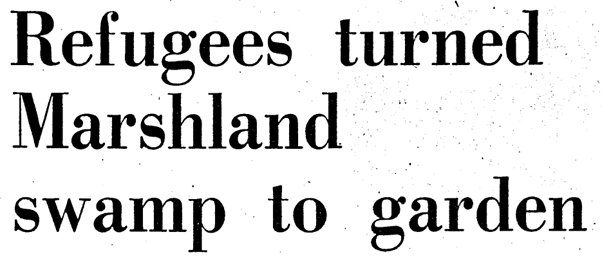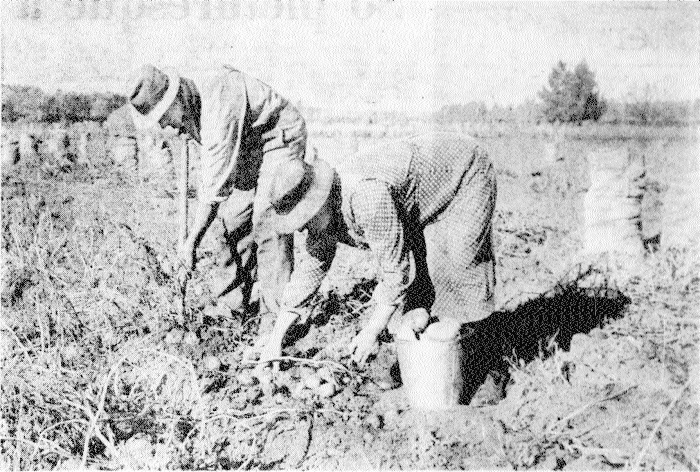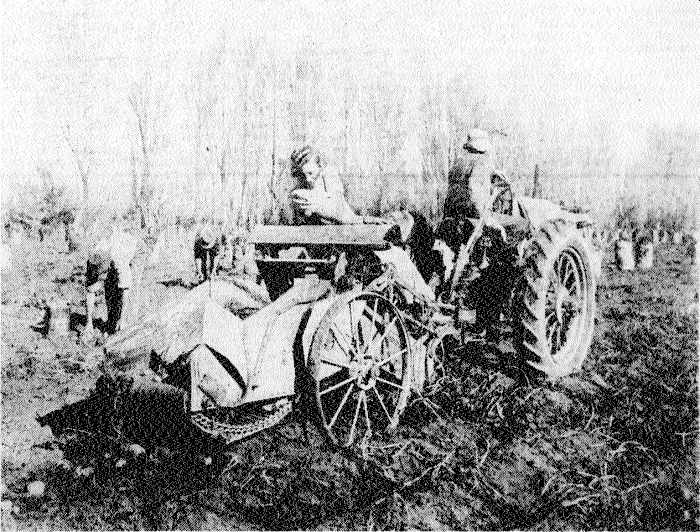The late Terry McGoverne wrote this article in 1975, when he was working for the press in Christchurch. We found it through papers past, and we are grateful that its copyright owner, Stuff Ltd, has made it available under the Creative Commons licence in New Zealand to be reproduced in non-commercial websites such as this. papers past, which is run through the National Library of New Zealand, Te Puna Mātauranga o Aotearoa, collaborated with the Christchurch City Libraries to digitise the article. Mr McGoverne died in Sydney in 2013.
We have copied the original 1975 headline, sub-head, and by-line, in memory of old journos everywhere. We have included some explanatory endnotes.



Bismarck, chancellor of Germany a century ago, was a great glutton of a man. Among other things, he wanted to drink 5,000 bottles of champagne and smoke 50,000 cigars before he died.
He probably did both. He also played a significant role, albeit unwittingly, in getting people to settle the most undesirable piece of land near Christchurch.
This year is the centenary of the settlement of Marshland, the district on the north-east side of Christchurch which is known throughout New Zealand for the bounty of its soil.
But what one sees as one drives down Marshland Road today—acre upon acre of neatly cultivated crops of onions, potatoes and greens—is far removed from what the district’s first settlers saw.
Who were they? Refugees from the tyranny of Bismarck the megalomaniac. Poles mainly, who had as much wish to be conscripted into the Prussian war machine as thousands of young Americans wanted to waste their lives in Vietnam.
Strangely, there are only one or two of the descendants of the first Polish families to settle in Marshland there now to celebrate the district’s centenary.
There are also a few families of German extraction, now third generation New Zealanders, who probably know little of the privations their forebears underwent to convert Marshland from a stinking swamp into a rich vegetable growing district.
The original Poles came from a remote village in [West] Prussia where the wheels of life were still controlled by the cogs of feudalism. For the Polish minority in this village, whose name is unknown, there was little better than slavery to look forward to.1
When Bismarck set out to expand the German empire he ordered the villages all over Prussia to send in conscripts for training.
To fight for the Germans was something the Poles would never do and many of them slipped under Bismarck’s iron curtain to make their way to the new world.
One of them was Matthew Schimanski who sneaked away one night, reached London and sailed from there with other Poles to New Zealand in 187[2].
About half the land in Marshland was at that time owned by Edward Reece and the other half by Robert Heaton Rhodes (father of Sir Robert Heaton Rhodes). Reece owned from Marshland Road to the sea and Rhodes, from Marshland Road to about Papanui Road.
In 1874 Reece heard about the Poles who had arrived at Holmes Bay on Banks Peninsula. He invited them, when he discovered their rural upbringing, to come and settle in Marshland. Families such as Schimanski, Boloski, Rogal and Gershearski were among the first to take advantage of his offer.
Mr Dick Boloski, a semi-retired farmer at Marshland, quotes his late mother2—who migrated from Poland at the age of three—as saying that the mercantile firm of Dalgetys actively recruited farm workers in Poland. That firm was responsible for bringing many Polish families to Canterbury. The Dalgety family formerly owned land at Marshland including that area now occupied by the Waitikiri Golf course.
Dalgetys bought some land from the original owner, Reece. Reece divided his land into blocks of 10 and 20 acres which he leased to the Poles for 30 shillings an acre.
As time went by, the Poles secured ownership by buying the land at £30 an acre which in those days was very expensive. Reece must have been aware that once the land came into production it would be worth a fortune.
Rhodes likewise sold his land in small blocks and by 1880 the district had been pretty well split up into the small holdings. The first settlers built cob and wooden houses along Briggs Road then ventured up Marshland Road hugging as much as possible the high spots on the generally soggy swamp.
By 1880 some families were so well established that they could afford to bring other relatives from Poland and Germany. Energetic, enduring and patient, the Poles of Marshland succeeded where the softer settlers from elsewhere might well have failed. There were successful British migrants in the district—Quaid, Walter and Hawkin whose names are given to roads there.
[The Poles’] victory over natural odds was perhaps greater than those of any other district of the kind in New Zealand. From dawn till dark both men and women worked with the same spirit of fiery independence which had driven them from their own country. Once they owned the land they were soon able to extract from the swamp its real worth.
The first and almost overpowering task confronting the settlers was to drain the land for until this was done the land could not be cleared of vegetation for cultivation.
Early drainage schemes in Christchurch were in the hands of the Avon Road Board, founded in 1862. This board began to look at Marshland and its minutes record the trouble it had in acquiring rights-of-way through privately owned land where drains would have to be cut.
Rhodes and another significant landholder of the day, C. E. Fooks, were able to persuade the small holders to let the board have access and as a result three large drains were cut through the district.
They were named Horner’s, Rhodes’ and Goodman’s drains into which other cuts later flowed and took water either north to the Styx River or south to the Avon River.
Once the land was cleared the farmers themselves put in closed drains. They cut their trenches, filled them with scrub manuka and filled them over again. Such drains were effective for about 10 years before silting up.
Responsibility for the main drains in Marshland passed to the Christchurch Drainage Board in 1910.
Once the drains began to do their work the farmers set about clearing the vegetation over a greater area and in the process harvested some of the abundant flax which was processed at mills in Lower Styx Road and Marshland Road.
The cleared land was ploughed with bullock teams and the first crops were carrots which the farmers thought ideal for breaking up the soil.
Not only that, the carrots could be sold readily at Riccarton where the Christchurch tramway stables were set up in the days of horse-drawn trams.
Horse racing had also begun to flourish at Riccarton and the demand for carrots was strong. Hence, the growers at harvest time would make their way to Riccarton and sell their carrots for 15 shillings a ton. They would return home with a dray load of horse manure and there are still those today who say that this commerce between Marshland and Riccarton was primarily responsible for the fertility of the Marshland soil.
The supply of such cheap fertiliser and soil conditioner was certainly of great benefit to the growers who got the stable sweepings for the taking.
As time went by and the drainage improved. Marshland began to sink or settle and, as it did, huge tree trunks emerged. Thunderstruck by this the settlers were confronted with an economic problem of enormous proportions. Eventually they paid more to remove the trunks than they had paid for the land. Even today, growers on some properties continue to turn up lumps of wood when they plough.
Kahikatea, matai and totara—the remnants of a prehistoric forest—had to be disposed of, but not by fire because if the peat was set on fire it would burn for days.
The wood had therefore to be stacked and no doubt allowed to dry for house firing in winter. For many years the great heaps of timber left ugly marks on the landscape.
The next problem confronting the settlers was wind damage to crops. As the humus content of the soil diminished it crumbled, and tended to blow away during strong north-westerlies. Often whole paddocks of onion seedlings would be torn from the ground.
The farmers solved this by planting belts of poplars which they kept cut back enough to let the sunlight in.
Growing onions in Marshland began not too long after the district was settled. Why the farmers picked on onions is not known but it is generally thought that the success of small domestic plots of onions prompted growers to take it on in a big way.
At first the growers strung their harvested onions and hawked them around Christchurch calling at hotels, boarding houses and the local markets.
As production increased the practice of bagging became widespread and a thriving export industry developed throughout New Zealand and Australia.


Harvesting potatoes in Marshland the back-breaking way (above), and with machinery (below).
The onion growing became so important that many families would exert themselves to the limit in the early cultivation period. Even the children at the local school would be given time off to help with the weeding at home.
Such a procedure is no longer necessary, of course. The development of weedicides eliminated the backbreaking task of hand weeding although there are people in Marshland who vow and declare that the lack of hand weeding is responsible for the present “dirty” state of the ground on some properties.
In 1939 the growers were hit by a reverse not unlike the potato cyst problem which knocked them this year. On March 7, 1939, the Department of Agriculture disclosed that Marshland was infested by two diseases—onion smut and yellow dwarf.
Things looked bad. The growers were told they could not export their onions for fear of transmitting the diseases to other parts of New Zealand or abroad.
The department insisted on some tough regulations about future crops and the subsequent co-operation of the growers, adopting treatment programmes, cleaned up the diseases. Ever since, growers have followed careful programmes of spraying to prevent the return of the diseases.
Since the last war, much of the land in the district has changed hands and many, discouraged by the returns in relation to the work required, have gone to other occupations.
Families with long connections with the district are now represented by only the odd grower or are no longer there.
The social life of the district has focused on the cheerful little rural school at the corner of Marshland Road and Prestons Road which has been there since 1888 and in its earliest days was also a night school for migrants wanting to learn English.
Founded on hard work, the district seems sure of remaining the food basket of Christchurch and so long as it does it will continue to be a memorial to the remarkable Europeans who founded it.
Footnote: It would be churlish not to acknowledge that most of the information in this article was collected by a young trainee schoolteacher, H. W. Hughes.
Hughes began a thesis on the Marshland district while working at the local school.3
But he never completed the work. He enlisted soon after the outbreak of war, and was killed on active service.
The link to the original story, which appeared on page 11 of the Press, 27 September 1975:
https://paperspast.natlib.govt.nz/newspapers/press/1975/09/27/11
Updated for this website in February 2023.
ENDNOTES:
- 1 - With today’s internet tools, modern researchers and family genealogists have been able to find the names of the villages their ancestors left. There were several, all in Prussian-partitioned north-western Poland, in areas known as Kaszubia and Kociewie.
- 2 - Augusta Schimanski married John Boloski in 1899. She arrived in Lyttelton on the Firth of Forth in 1883 with her parents, Christopher and Louise Schimanski, stepbrothers Martin and Michael, sisters Julia and Mary, and brother John, who was born at sea. John Boloski was born in Christchurch in 1876. His parents, Joseph and Dorota, were among the first large group of Polish settlers to New Zealand in 1872.
- 3 - Our story, Marshland: The Place Where Flax Grows Profusely, expands on Hughes’ work.
https://polishhistorynewzealand.org/marshland/
